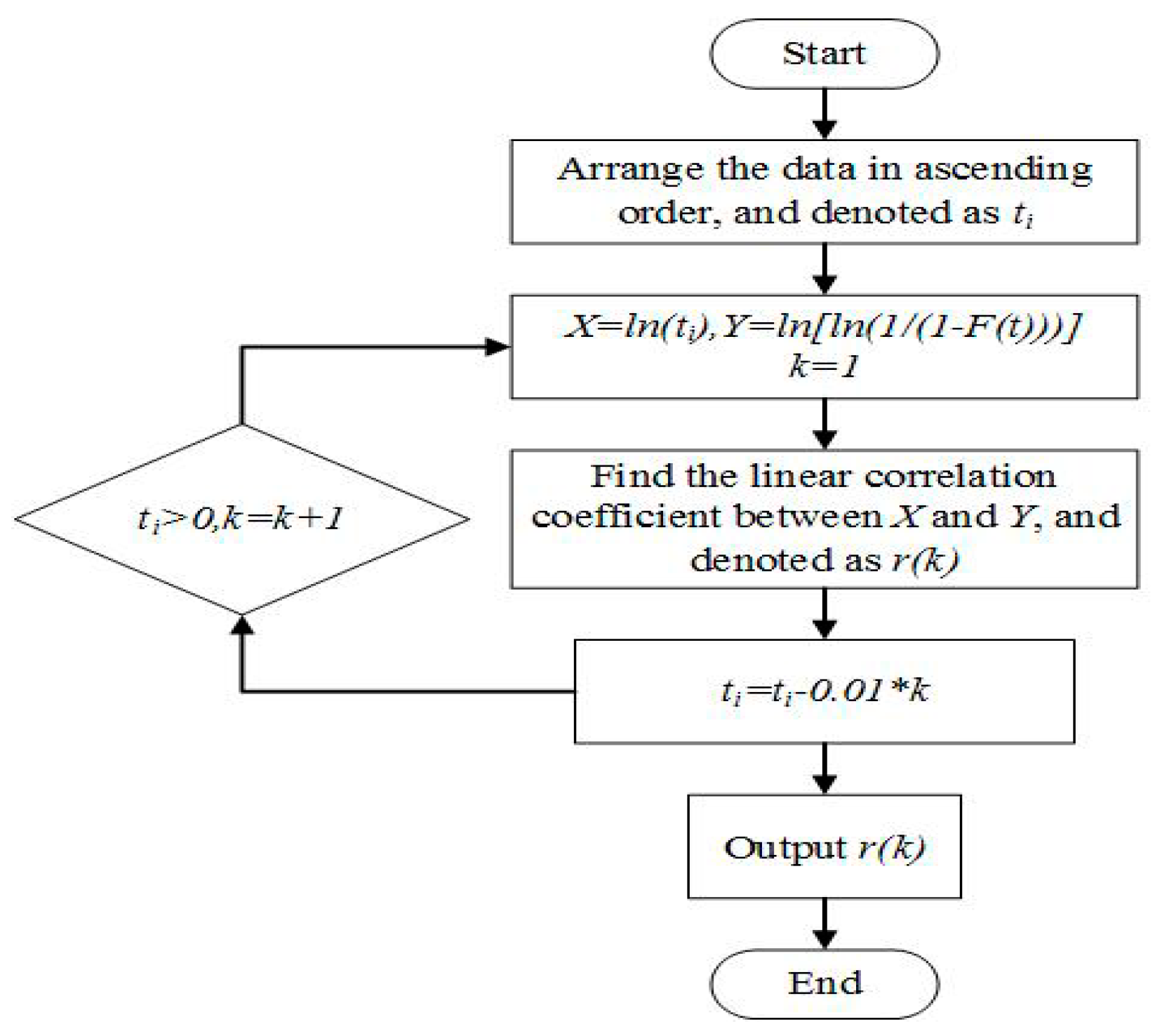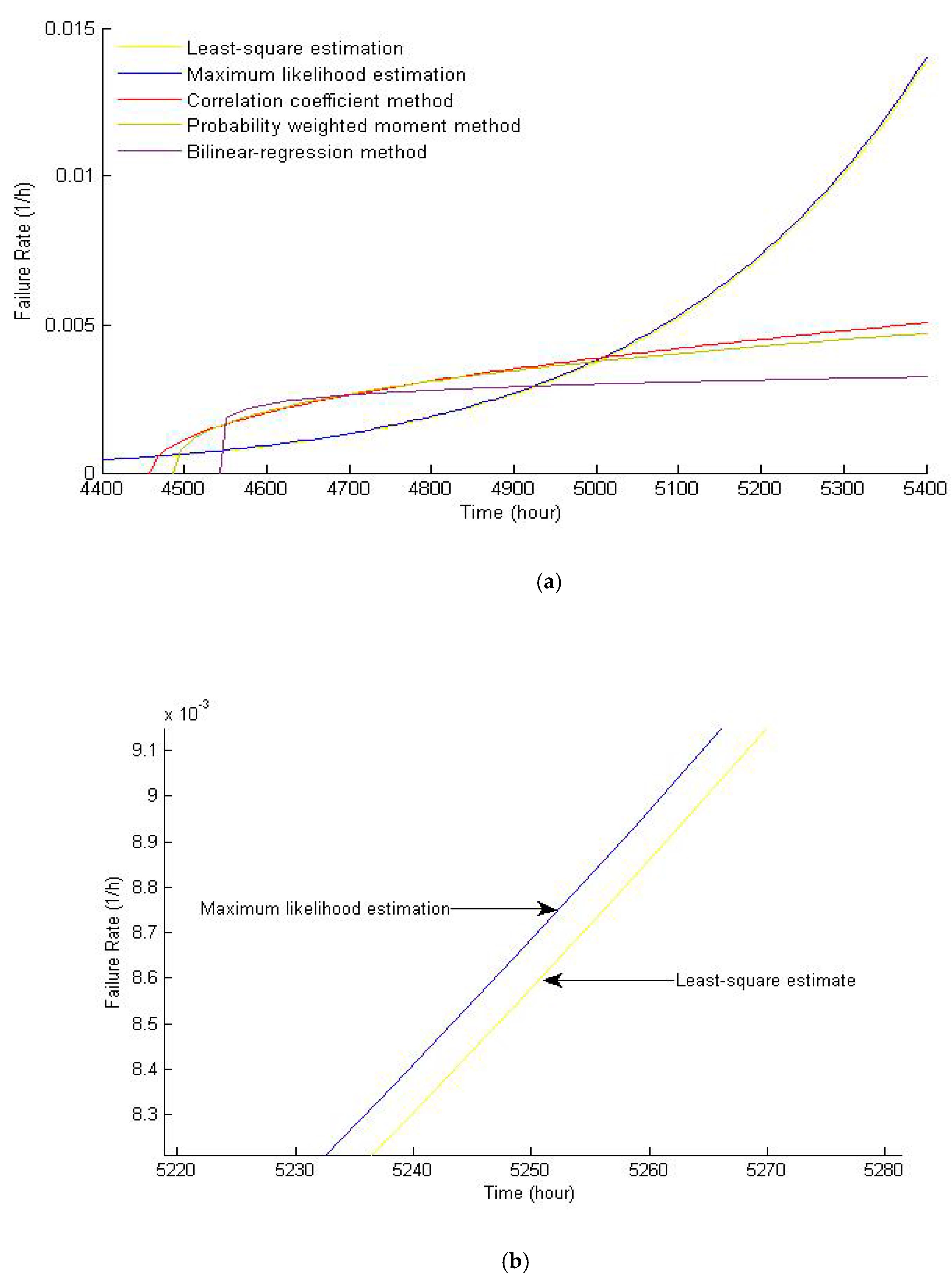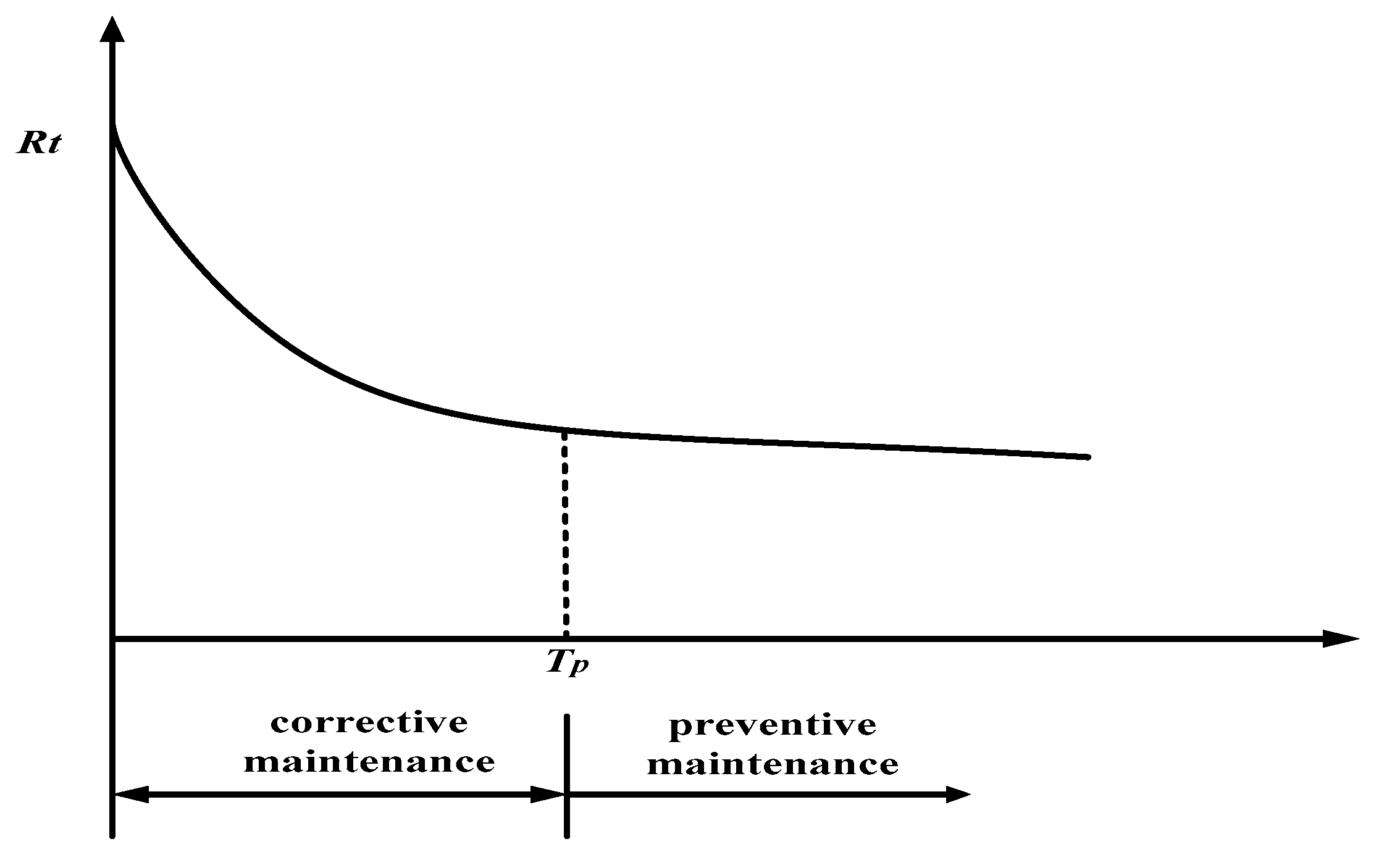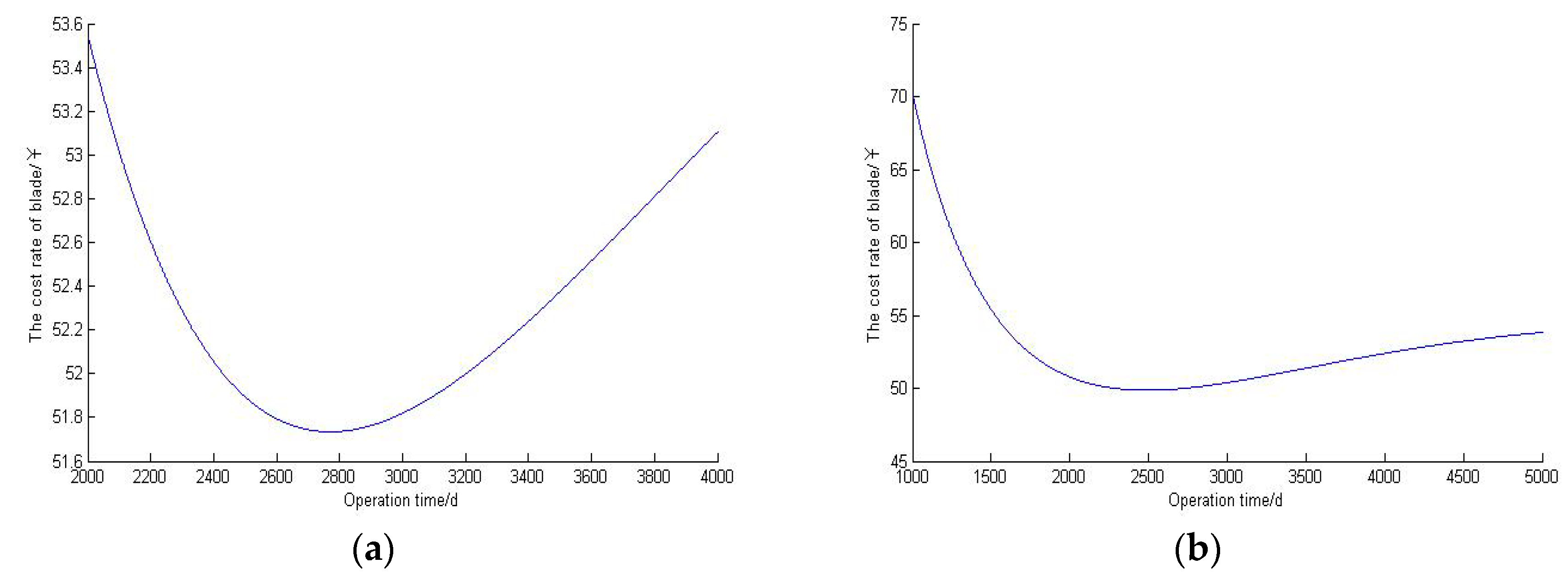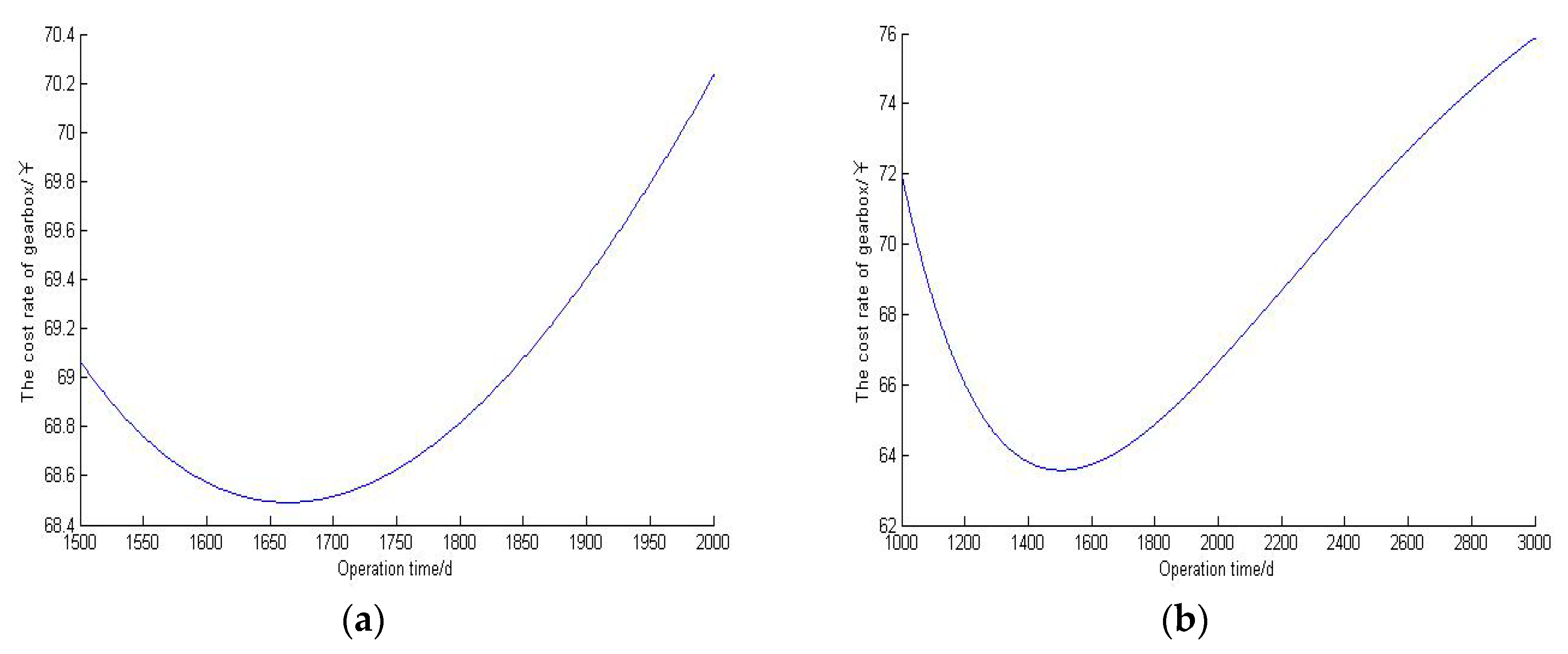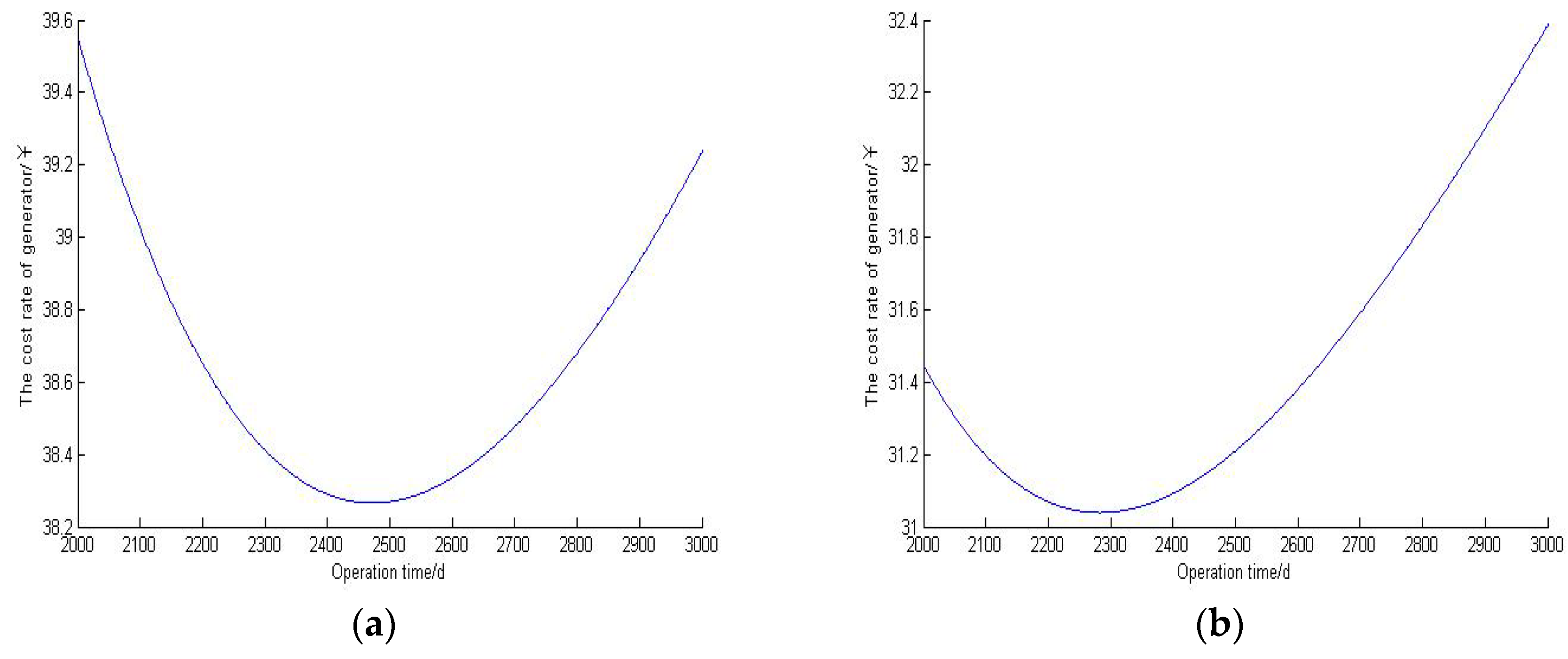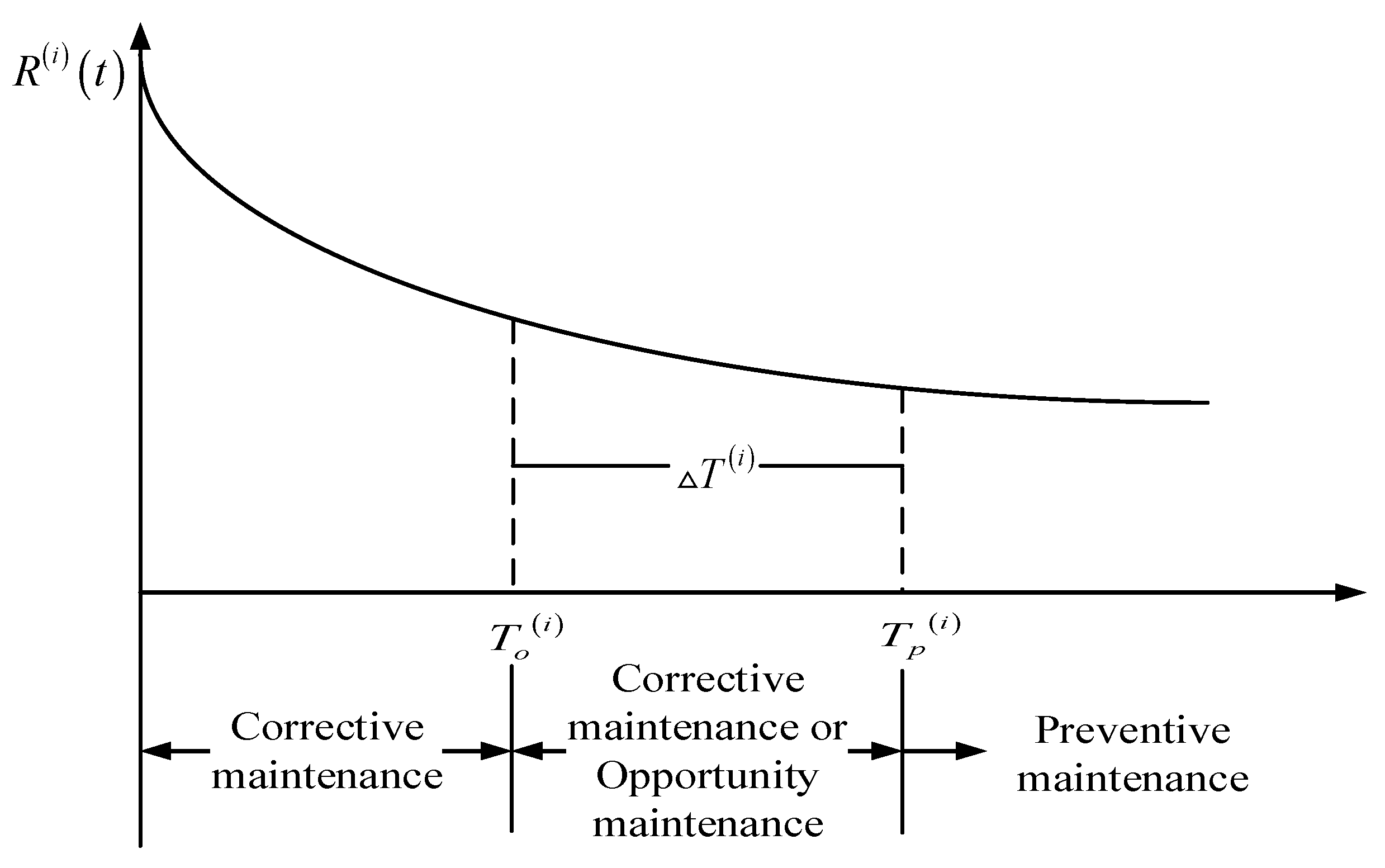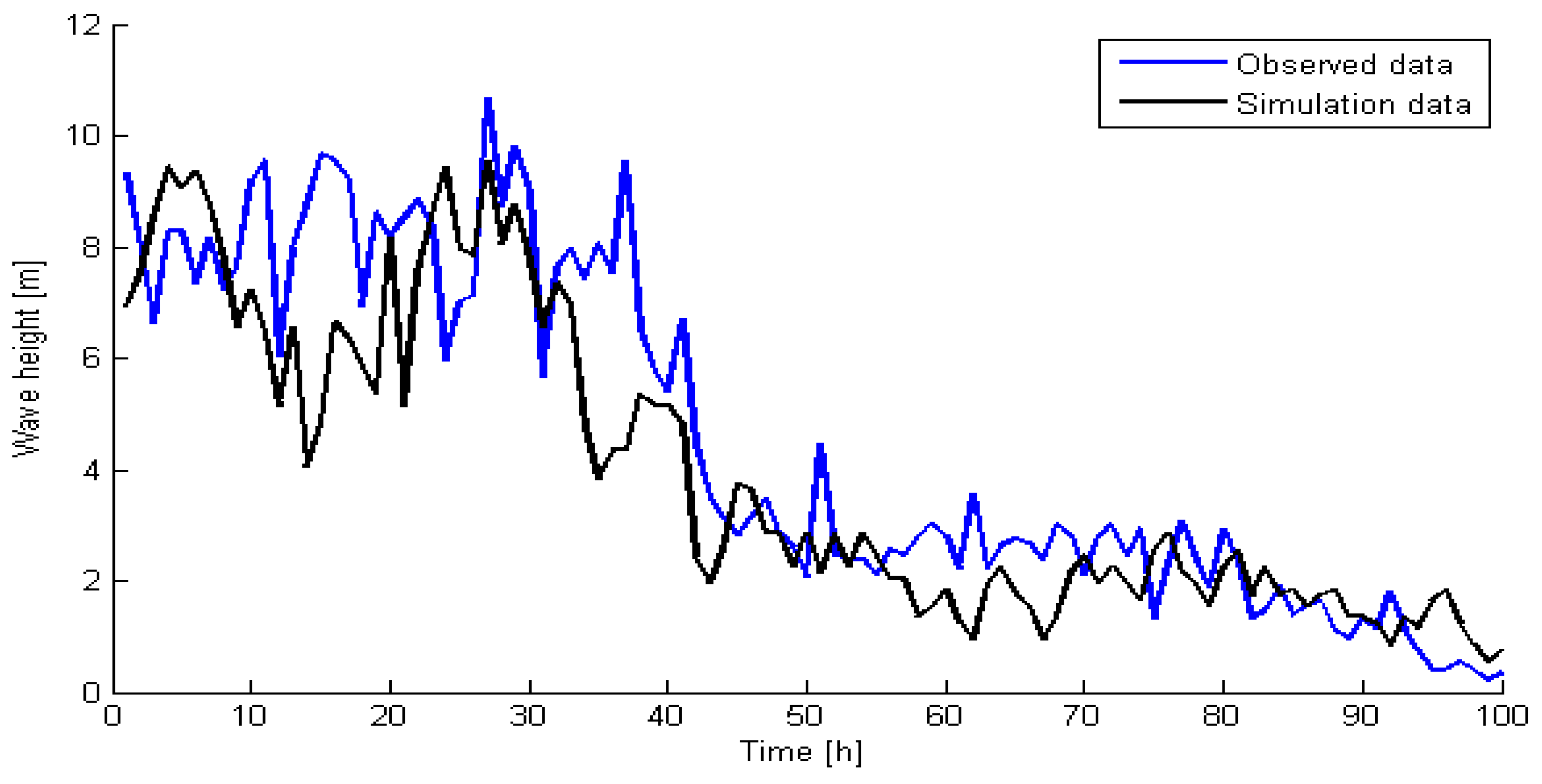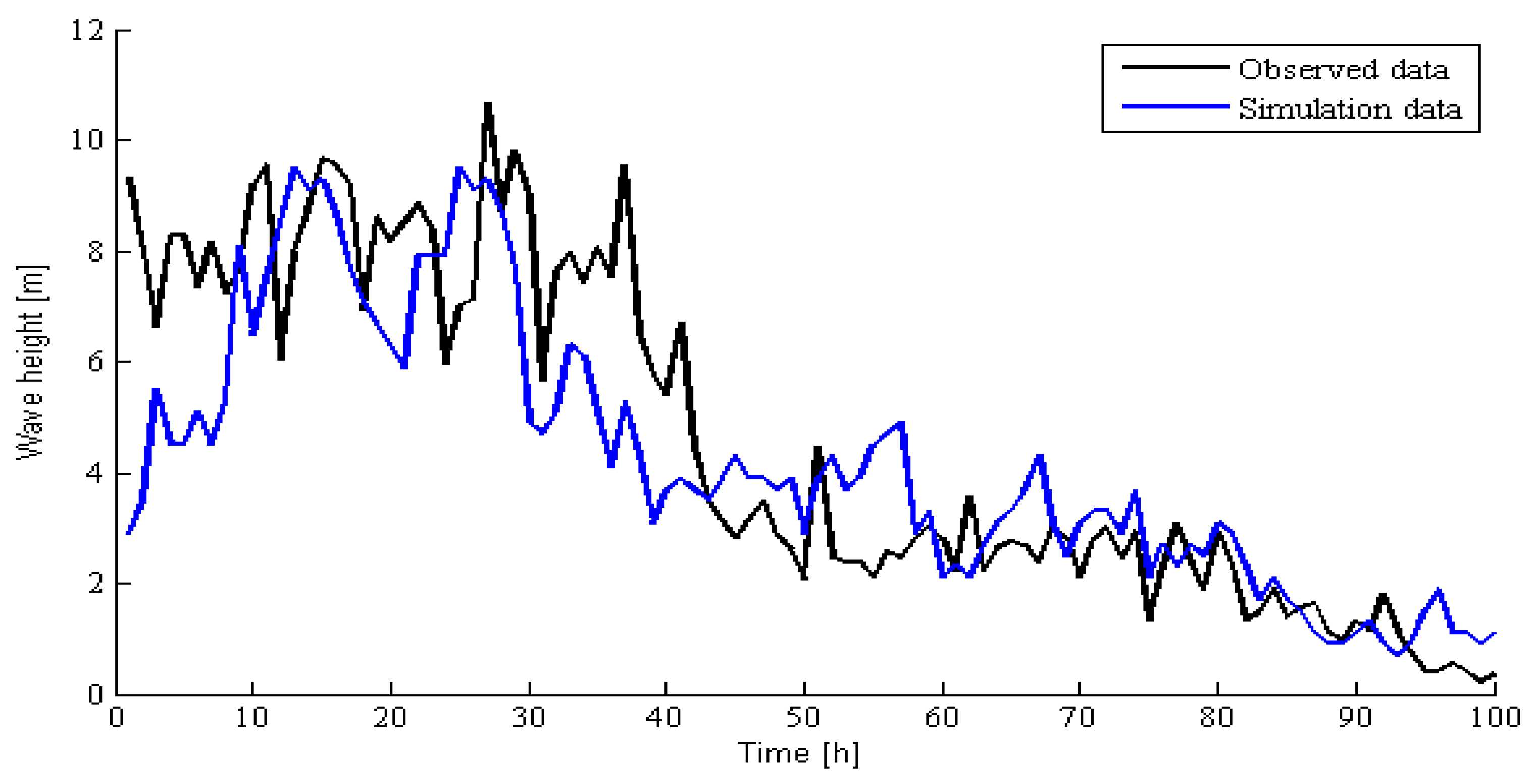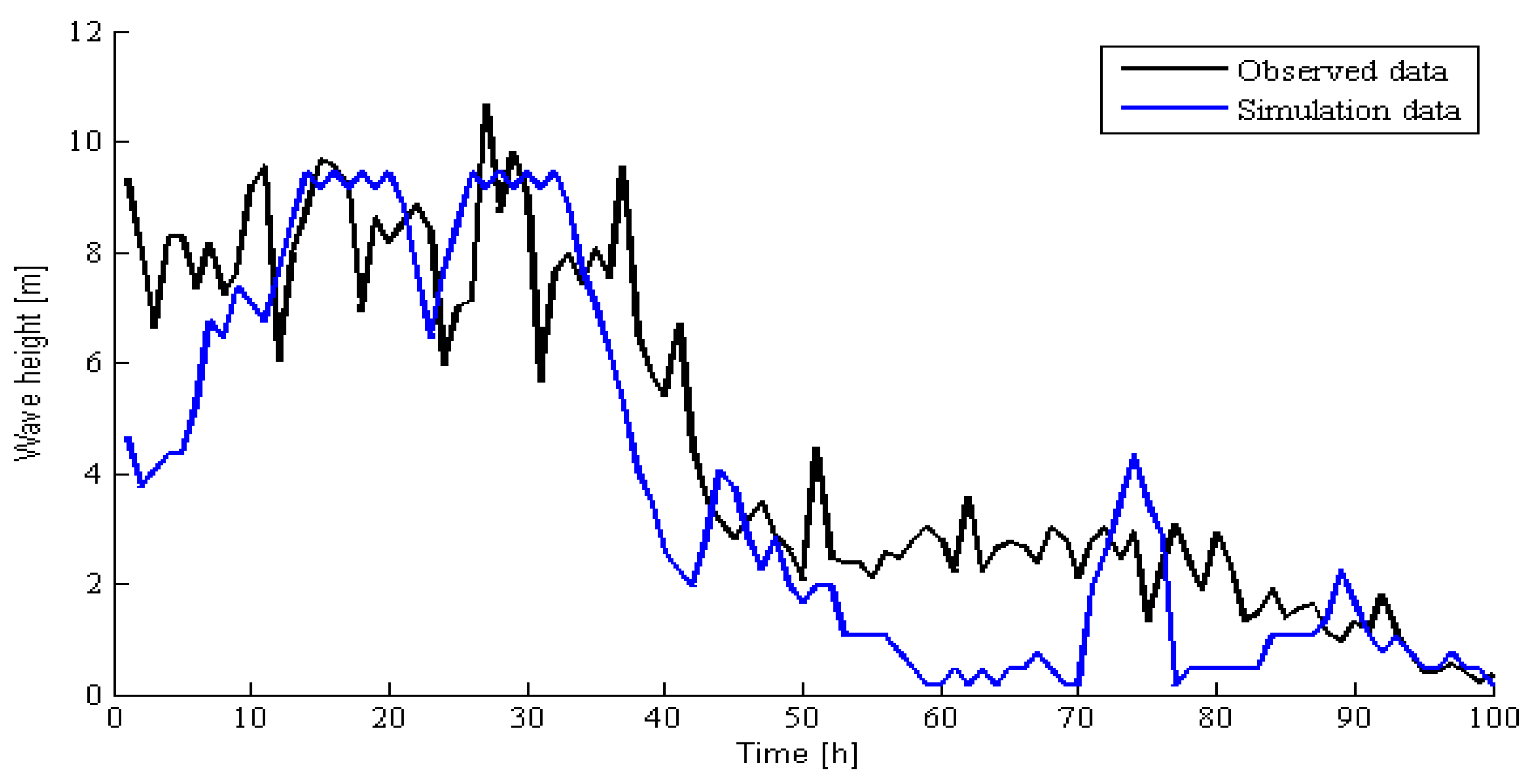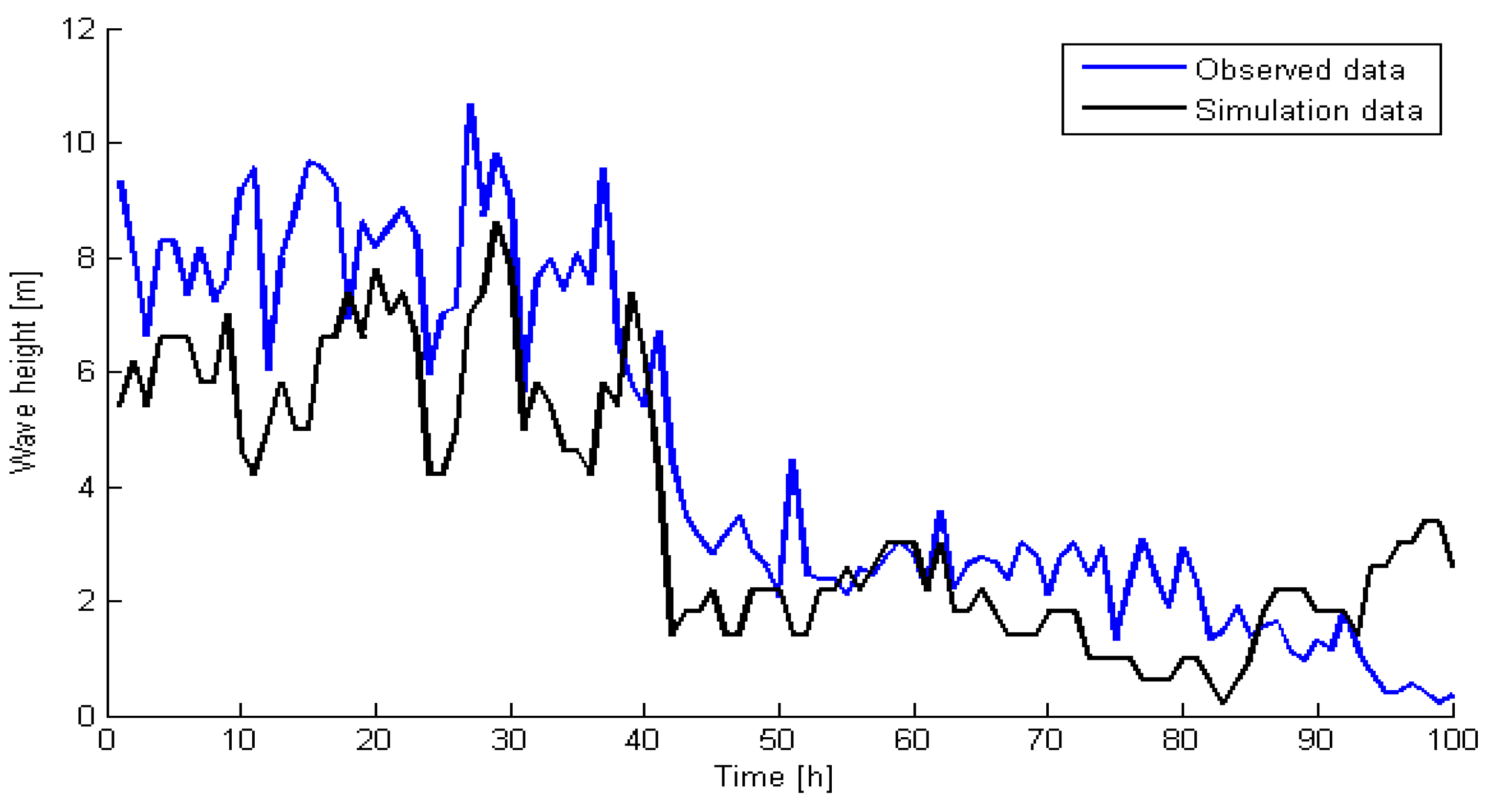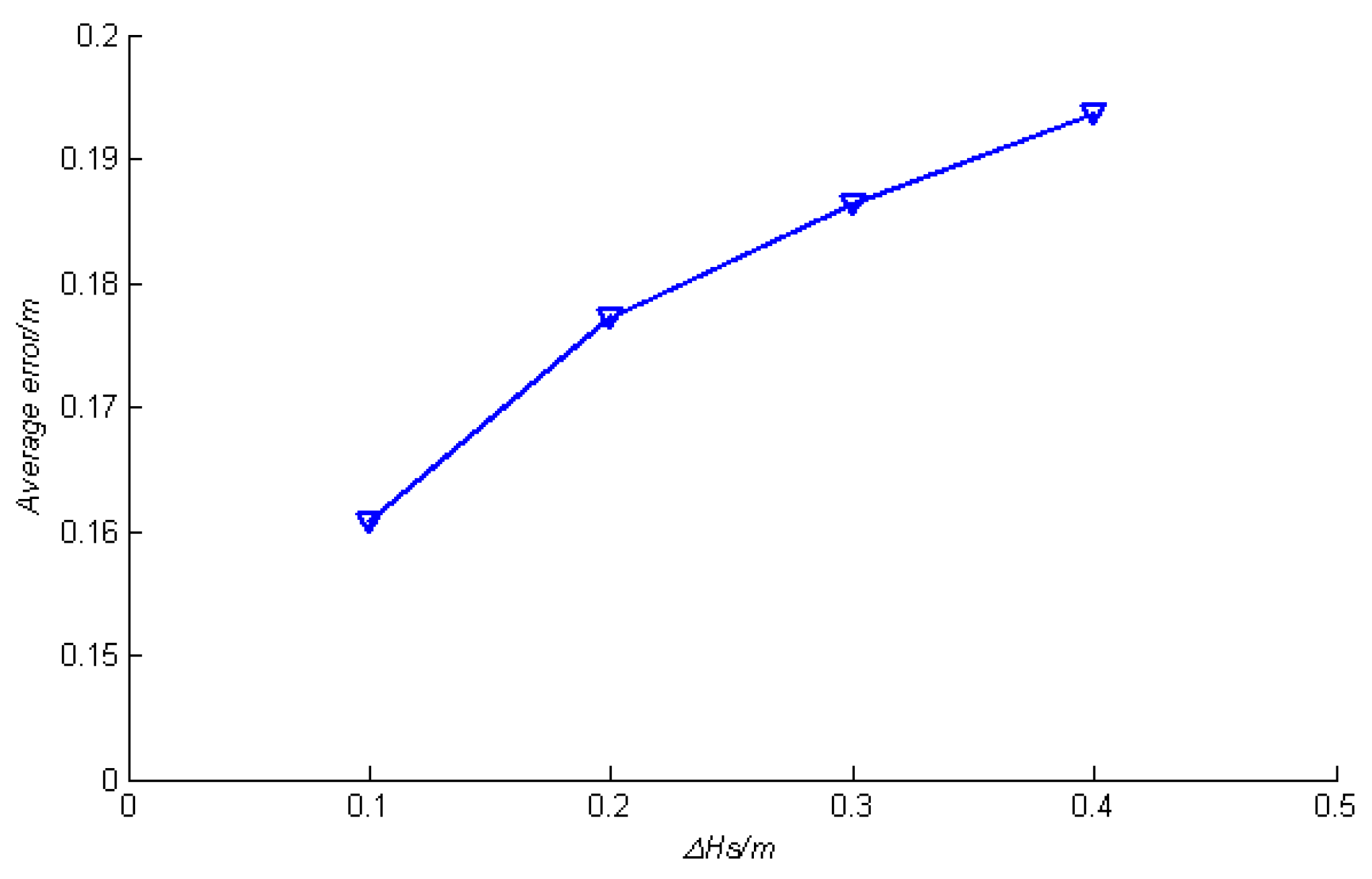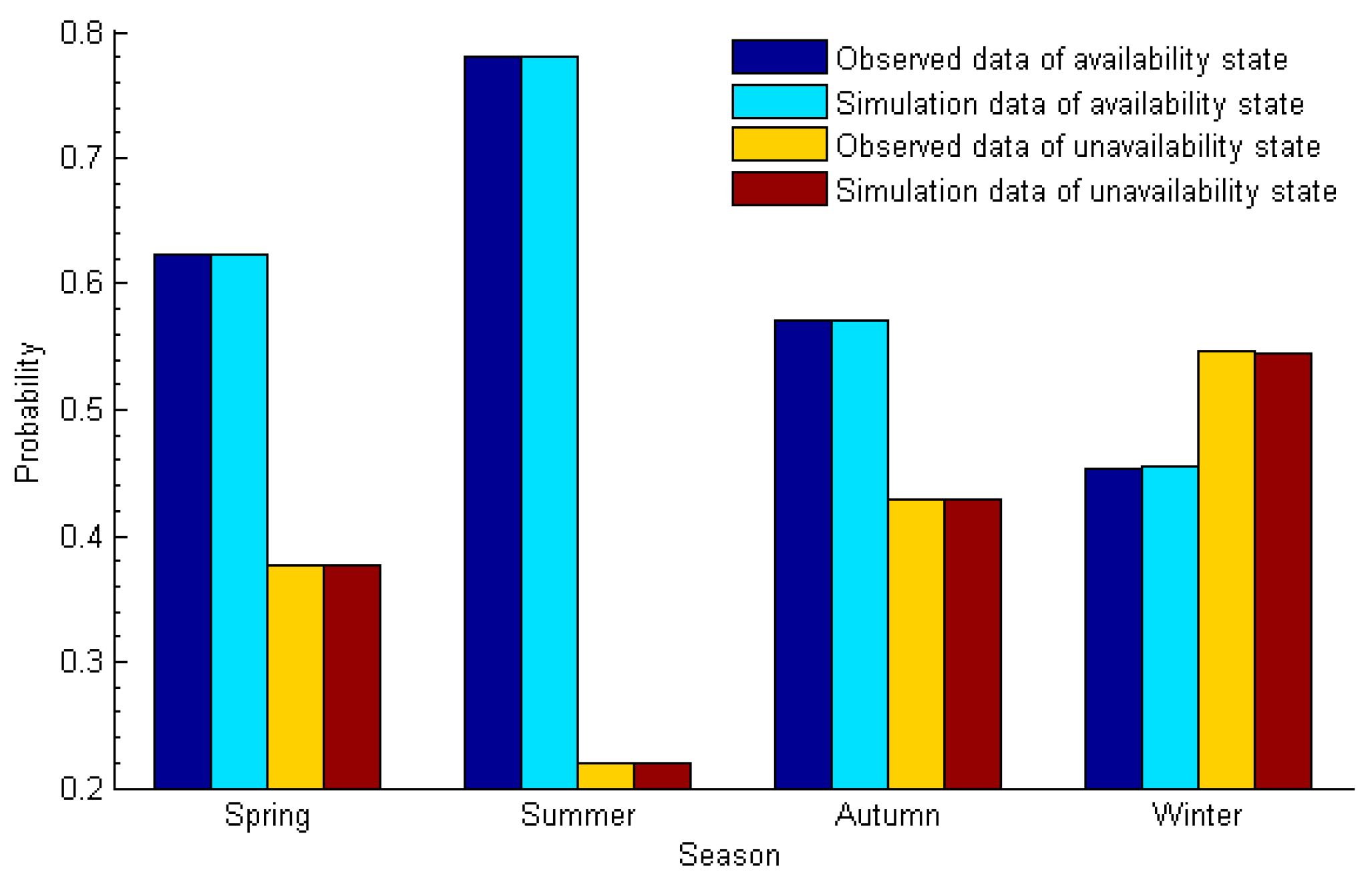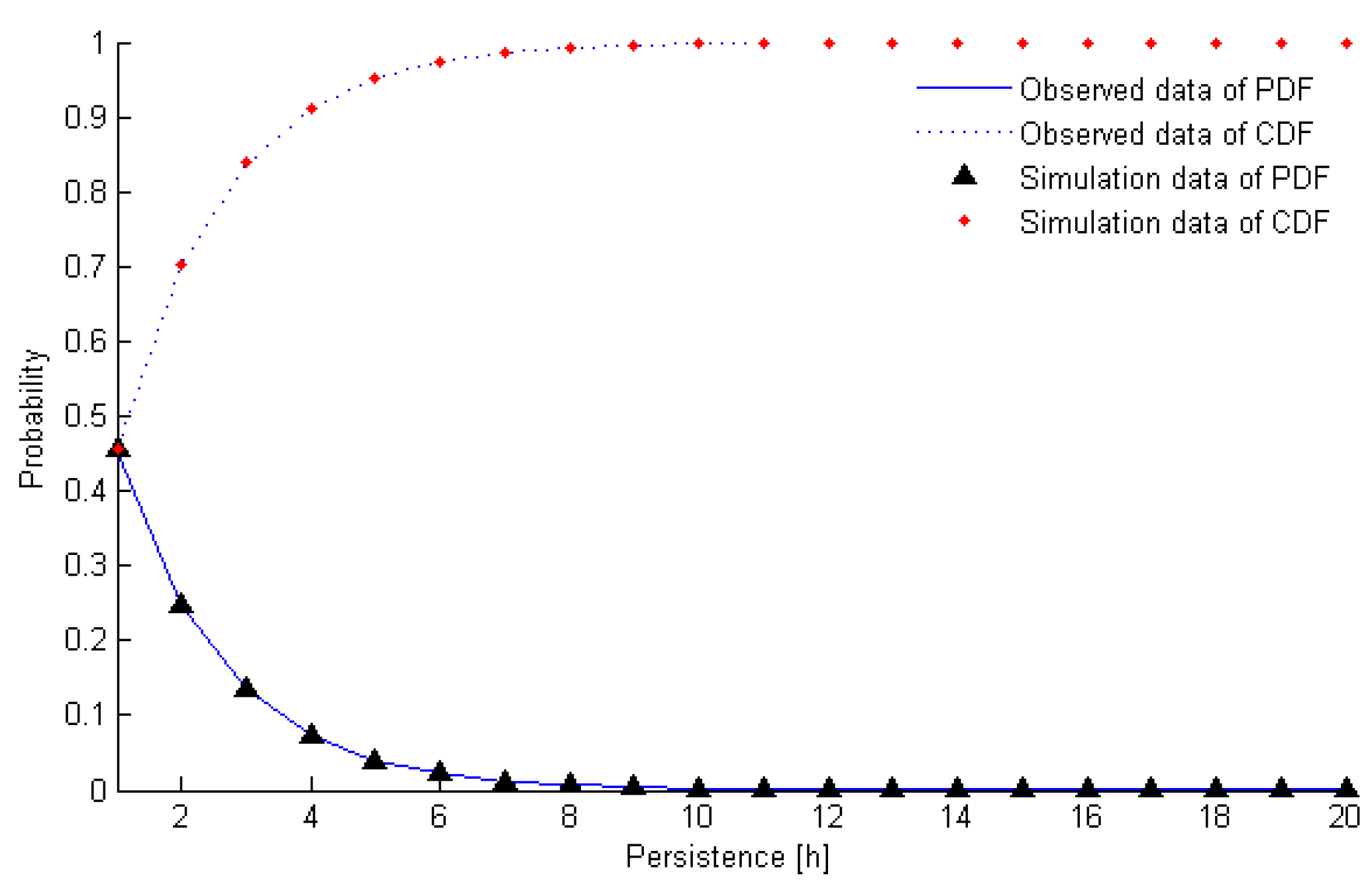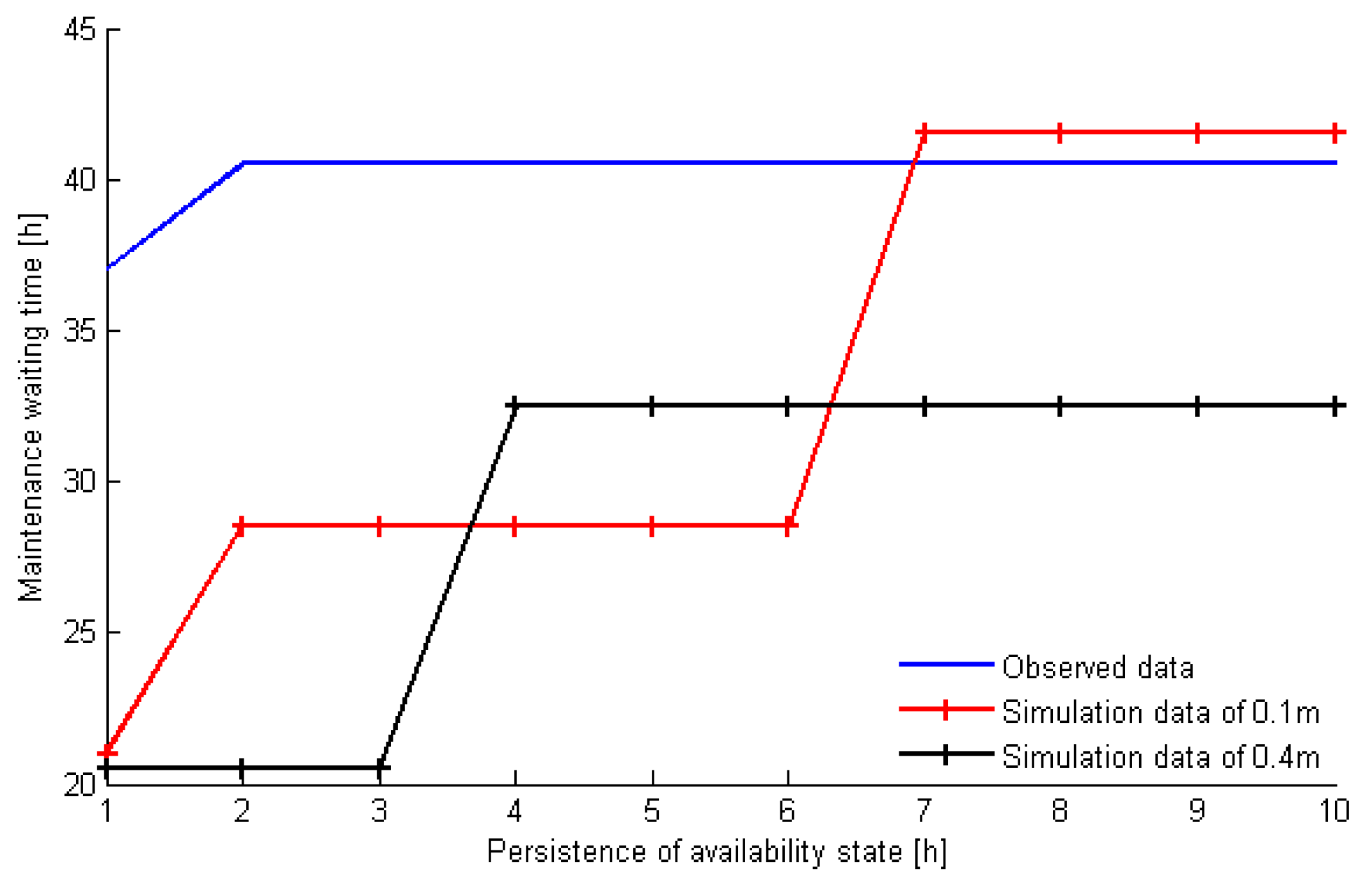1. Introduction
In recent years, the wind power industry has made rapid progress globally. Due to abundant offshore wind energy resources, the installed capacity and power generation of offshore wind power are growing rapidly [
1]. However, considering the large investment and high risk involved in offshore wind power, and the influence of weather conditions, the requirements for offshore wind farms in terms of operation and maintenance vessels, spare-parts management, and other influential factors are more strict. The special operating environment of offshore wind turbines, in which the equipment is affected by natural conditions, such as typhoons, tides, waves, can accelerate the failure of unit components, and the increased failure rate of electrical and mechanical systems finally leads to lower reliability. Thus, the reliability of wind turbines has become an important issue.
The Weibull distribution is an important statistical measure in reliability engineering, known to have good adaptability and availability for various forms of failure rate simulation in relation to mechanical and electrical products. In this paper, the construction of a Weibull equation is pursued. Based on the two-parameter Weibull equation, a location parameter was introduced to create what is known as a three-parameter Weibull equation. Many researchers are interested in three-parameter Weibull equations. In [
2], a three-parameter Weibull distribution was used in the asphalt‒concrete fatigue assessment of aging. In [
3], optimization of distribution was studied for an inventory system established by Weibull. In [
4], a three-parameter Weibull distribution was proposed in a study on the mechanical sector. In [
5], the three-parameter Weibull distribution equation was applied to predict wind power density. In [
6], a mixed Weibull distribution parameter estimation method was discussed. In [
7], the Weibull distribution was studied by using the three best linear unbiased parameter estimation based on previous unbiased estimation and quasi-optimal linearity. This literature review reveals that the three-parameter Weibull equation has been used in many fields, including machinery, architecture, and aerospace; however, so far few applications of the three-parameter Weibull distribution have been used in fault prediction for offshore wind turbines, especially for those with limited fault data.
Moreover, access to offshore wind farms is greatly restricted by wind and wave conditions, which hinders the operation and maintenance of the unit, thus resulting in an increase in outage time, a decrease in the availability of units, and an increase in operation and maintenance costs. It is necessary to consider the impacts of sea weather conditions related to unit operation and maintenance. The impact of weather conditions on wind turbine maintenance strategies has been investigated in previous works. In China, in [
8], a wind turbine reliability evaluation method was proposed. Considering the special operating environment of offshore wind turbines, in [
9], the impacts of weather, accessibility, and maintenance time on the maintenance strategy of offshore wind turbines were analyzed. In [
10], an offshore wind turbine maintenance strategy with minimum cost and maximum reliability was established, considering the influence of wind speed and maintenance waiting time. In [
11,
12], a normal behavior model was proposed to further investigate wind turbine vibration and fatigue load by using neural networks and a stochastic approach considering the influence of wind speed. In [
13], a survey of stochastic models for sea state and different offshore wind farms was made according to the different maintenance schemes of offshore wind turbines, combined with the failure rate and maintenance time for various components of the unit. In [
14], a novel method for simulating wind and wave conditions for offshore sites was revealed, and the result indicated that the persistence of weather windows for significant wave height values can be captured by this approach. All these tests show promising results, and the weather model has been deemed accurate enough for simulations of offshore wind parks. Moreover, in [
15], a Markov model based on a statistical analysis of wind speed and wave height was established, and finally, the predictions were made for maintenance waiting time. Although there have been some related studies on the effect of weather conditions on offshore wind turbine maintenance strategies, wind speed and wave height have not yet been simultaneously considered to evaluate the accessibility of offshore wind turbine maintenance.
Meanwhile, many researchers have theoretically investigated the opportunistic maintenance strategy from a different perspective. In [
16], a two-level maintenance threshold strategy for wind farms was developed, considering opportunistic maintenance and imperfect maintenance based on reliability. In [
17], opportunistic condition-based maintenance for systems subjected to degradation and shocks was proposed to determine an optimal maintenance policy for multi-bladed offshore wind turbines. In [
18], a new bi-objective opportunistic maintenance optimization model was proposed, and a three-phase discrete event simulation was used to evaluate the performance measures considering the stochastic behavior of wind and limited maintenance capacity. In [
19], an opportunistic maintenance approach for wind farms was developed to take advantage of the maintenance opportunities, considering imperfect maintenance actions. In [
20], the trade-off between wind farm configuration and the maintenance strategy was investigated by a new bi-objective redundancy and maintenance optimization model.
The primary goal of this research is to carry out studies in an effort to reduce the operating costs of offshore wind turbines. In this paper, the impacts of weather conditions on the maintenance activities are considered, the Markov chain method and dynamic time window are introduced to represent the weather conditions, and a maintenance waiting time is proposed for offshore wind turbines. In addition, the opportunistic maintenance strategy was used to optimize the key components of the maintenance of the offshore wind turbines. Furthermore, the minimum maintenance cost within the maintenance duration was deemed the optimal objective, and the preventive maintenance time and opportunistic maintenance time have been optimized for the main components of wind turbines. In particular, the novelties can be reflected in the following aspects: (1)The three-parameter Weibull method, instead of the two-parameter Weibull method, was applied to the reliability analysis of offshore wind turbines with limited fault data; (2) the Markov chain method was adopted to evaluate the prediction of maintenance waiting time, considering the wind speed and wave height simultaneously; (3) the preventive opportunistic maintenance strategy has proven to be one of the methods available to generate maintenance cost efficiency, instead of the preventive maintenance strategy.
The remainder of this paper is organized as follows.
Section 2 introduces the two-parameter Weibull model of onshore wind turbines by the least squares and maximum likelihood methods, and the three-parameter Weibull model of offshore wind turbines by the correlation coefficient, probability-weighted moment, and bilinear regression methods. In
Section 3, we describe the construction of a Weibull equation for offshore wind turbines based on scant sample fault data.
Section 4 describes the Markov prediction method. In
Section 5, we develop an opportunistic maintenance strategy based on accessibility evaluation.
Section 6 gives the opportunistic maintenance simulation based on maintenance waiting time. In
Section 7, we propose conclusions and recommendations from our study and suggest areas for further research.
2. Reliability Analysis Model for Wind Turbines
For wind turbines, the commonly used reliability analysis model is the Weibull distribution. This distribution is derived from the analysis of material strength by Weibull. It is a very important distribution form in reliability engineering [
21]. The probability density function of the Weibull model obtained from the weakest link theory is
Its distribution function is given by
Its inefficiency function is given by
In Equations (1) and (2), α is the scale parameter, is the shape parameter, , and is the position parameter, . is the threshold value for failure, is used to describe the dispersion of the measured values, and is related to the average measured values.
In the failure analysis of the product,
is associated with the failure mechanism of the product, and the different values of
are accompanied by different fault mechanisms. When
, the failure-rate function is a decreasing function, showing the life distribution of products under the wear-out failure period. When
, the failure-rate function is constant, representing the products in the life distribution of the random failure period. When
, the failure-rate function is an increasing function, showing the distribution of products in the period of life [
22].
2.1. Weibull Model of Onshore Wind Turbines
For onshore wind turbines, because of their simple operating conditions and abundant operation and fault data, in practical applications, the common assumption is that the device fails at time
, and the corresponding expressions, Equations (1) and (2), respectively, can be simplified as follows:
At present, the two-parameter Weibull analysis method is roughly divided into several categories, i.e., least-squares estimation, median rank regression, maximum-likelihood estimation, and method of moments. For engineering purposes, maximum likelihood is usually considered first due to its high accuracy, as compared to method of moment, which tends to be adopted only if the maximum likelihood function will be difficult to construct. In this paper, we used maximum likelihood rather than method of moment.
Practically, median-rank regression can perform well in the case of extreme values occurring when the number of failures is small. Generally, based on the least squares method, the mean variable will be replaced by the median-rank variable so as to alleviate the estimated deviation caused by the extreme value. In this study, the maintenance optimization was based on a small sample, and the extreme value was carved out; therefore, the least squares method, rather than median-rank regression, was pursued, as follows.
2.1.1. Least-Squares Estimation
By the principle of extremum, the equation can be defined as follows:
The solution equation is shown as follows:
The two-logarithm transformation of Equation (5) is
Comparison with the one-element linear-regression equation gives:
Parameters and can be obtained from Equation (7).
2.1.2. Maximum-Likelihood Estimation
Maximum-likelihood estimation is an effective method of parameter estimation. It has strong applicability, especially in the case of incomplete life. The basic idea is to select the undetermined parameters first so that the probability of samples appearing in the field of observation is greatest; then the sample value is taken as the unknown parameter’s point estimated value [
23].
The likelihood function is
For the convenience of calculation, the logarithm of Equation (10) is taken as a natural logarithm:
Then, the likelihood equation is given by
Solving the equation gives the parameters and .
2.2. Weibull Model of Offshore Wind Turbines
The three-parameter Weibull distribution is used in the life tests of materials with a low stress level, which have better characteristics of curve fitting as compared to the two-parameter Weibull distribution. In the Weibull distribution function, the positional parameter is the threshold value for the failure time of targeted devices and is used to estimate the earliest failure time. Changes in positional parameters will affect the curve displacement of the probability density curve. Generally, when the unit operation time exceeds the positional parameter, the unit starts to fail.
In contrast with onshore wind farms, the conditions of operation and maintenance of offshore wind farms are extremely complicated due to tidewater, typhoons, and corrosion, which result in an increasing probability of the unit components’ failure as well as increased maintenance costs. In addition, due to the particularity of the environment, when a unit failure occurs at an offshore wind farm, maintenance personnel may not be able to reach the site for several months due to harsh weather conditions, which results in difficulty in obtaining component failure data and failure models. Therefore, it is crucial to carry out reliability prediction as soon as possible.
As part of our research, we performed a comparative analysis of the two-parameter Weibull distribution and the three-parameter Weibull distribution. The Weibull three-parameter equation prevails in short-term failure prediction and can be used effectively before t = γ. With regard to short-term failure rate prediction, an abrupt and abnormal rise in the failure rate has taken place under the two-parameter Weibull distribution. On the contrary, the failure rate curve under the three-parameter Weibull distribution displays a rational and smooth rising trend.
However, three parameters exist at the same time, so estimating the parameters of the three-parameter Weibull distribution is difficult. The least-squares method and the maximum-likelihood method are no longer applicable to the three-parameter Weibull distribution. MATLAB is a mathematics software produced by MathWorks. It is a high-level technical computing language and interactive environment for algorithm development, data visualization, data analysis, and numerical calculation, mainly including MATLAB and Simulink. The paper applied MATLAB software for data calculation and simulation.
2.2.1. Correlation Coefficient Method
The two-logarithm transformations of Equation (2) are obtained by
Equation (13) is changed into
The relationship between
X and
Y is a linear relationship, as shown in Equation (14). Equation (14) shows that when the estimate of
is correct, a linear relationship exists between
X and
Y, i.e., the correlation coefficient between
X and
Y is a maximum. The correlation coefficient
between
X and
Y is obtained by
According to the flowchart shown in
Figure 1, column vectors containing (
k − 1), correlation coefficients are obtained. The step size
p can be adjusted according to the actual situation and is selected as 0.01 in the paper. The correlation coefficient
initially increases and then decreases. The position of the corresponding maximum correlation coefficient is found as
N, and the optimal estimation value of the position parameter is recorded as
After obtaining the estimated value of the position parameter, we can obtain the estimated value of the parameters by least-squares or maximum-likelihood estimation.
2.2.2. Probability-Weighted Moment Method
For small samples, probability-weighted moments are unbiased and have small errors; this is suitable for the reliability assessment of offshore wind turbines with a small amount of sample data. Therefore, the probability-weighted moments of the sample are used to estimate the distribution parameters, and the accuracy is high.
The inverse probability distribution function for the random variables
X of the Weibull three-parameter distribution, which is shown in Equation (17), is obtained using Equations (1) and (2).
From this equation, the following can be obtained:
Let
; then
The equation is solved, and the estimated values of parameters
,
,
can be acquired.
2.2.3. Bilinear Regression Method
Least-squares estimation is a linear-regression analysis method for a linear equation. It can only be used to solve two-parameter estimation problems. For the estimation of three parameters, two linear equations must be combined.
Let
; then, Equation (2) can be transformed as follows:
Equations (21) and (22) are linearly independent; they are linear equations that can be expressed as
and
can be depicted, respectively, as
According to the least-squares method, Equations (21) and (22) can be substituted into Equation (7) separately, and the combination can be obtained:
As long as the accuracy is given, the values of and can be estimated iteratively, and Equation (24) is substituted to obtain the estimated value of .
7. Conclusions
Before concluding, one additional point needs to be discussed. Because the operating environment of offshore wind turbines is complex, wind is a crucial factor that should be considered in optimal maintenance decisions. Moreover, the randomness of wind impacts on the power generated by wind turbines, which contributes to unsatisfactory energy costs. In this paper, the influence that fluctuations in wind speed had on the costs of offshore wind farming was considered in the determination of maintenance waiting time. From the perspective of reducing the entire-life costs of an offshore wind farm, we paid attention to how much maintenance costs will be reduced with the introduction of the opportunistic maintenance strategy. Actually, in this sense, how the wind fluctuation will act on the unit cost is not the research priority in this study. Indeed, the influence of wind fluctuation and grid impact on the unit is worth intensively study in further research.
In this paper, we attempted to analyze the characteristics of operation data of offshore wind turbines and investigated reliability analysis methods for offshore wind turbines based on limited fault data. Considering the influence of weather factors, such as wind speed and wave height, we studied maintenance waiting time prediction methods for offshore wind turbines. Combining failure maintenance and preventive maintenance, we proposed an opportunity-based offshore wind turbine maintenance strategy. The main study results are as follows:
- (1)
The construction of a Weibull equation for offshore wind turbines was based on a small amount of sample fault data. Different to [
8], based on the construction of a two-parameter Weibull equation, a three-parameter Weibull equation was proposed. The results show that the maintenance costs can be reduced by 8% with the adoption of a three-parameter Weibull model, and the fitting curve and failure rate short-term prediction of the three-parameter Weibull distribution is superior to the two-parameter Weibull distribution where there are limited fault data;
- (2)
A maintenance waiting time prediction method was introduced for offshore wind turbines. The Markov chain method and dynamic time window were used to describe wind speed and wave height, and a maintenance waiting time prediction model was established. Different to [
9], the impacts on maintenance waiting time arising from wind speed and wave height were considered in this paper. The results show that the deviation of the predicted value of the wave height obtained by grouping interval with ∆
Hs = 0.1 m was the smallest, which was close to the true value;
- (3)
Combining failure maintenance and preventive maintenance, an opportunistic maintenance strategy was presented for offshore wind turbines. The minimum expected maintenance cost was regarded as an objective function to optimize the opportunistic maintenance time and preventive maintenance time. Compared with [
10], the opportunistic maintenance strategy reduces maintenance duration and decreases the maintenance waiting time and downtime, thereby reducing maintenance costs. The results show that the maintenance cost was reduced by 10% under the opportunistic maintenance strategy for offshore wind turbine maintenance, which verified the effectiveness and superiority of the opportunistic maintenance strategy for offshore wind turbine maintenance.
